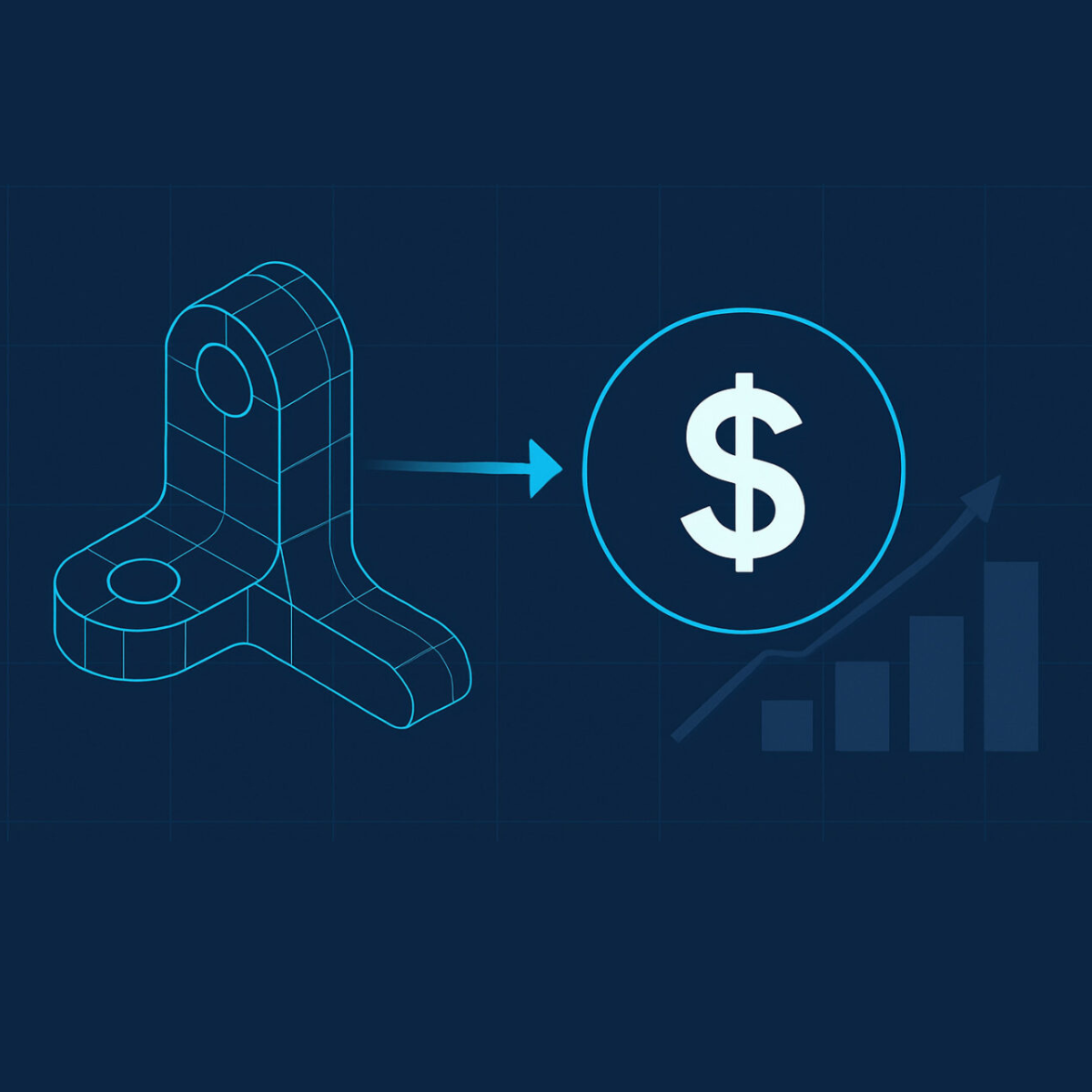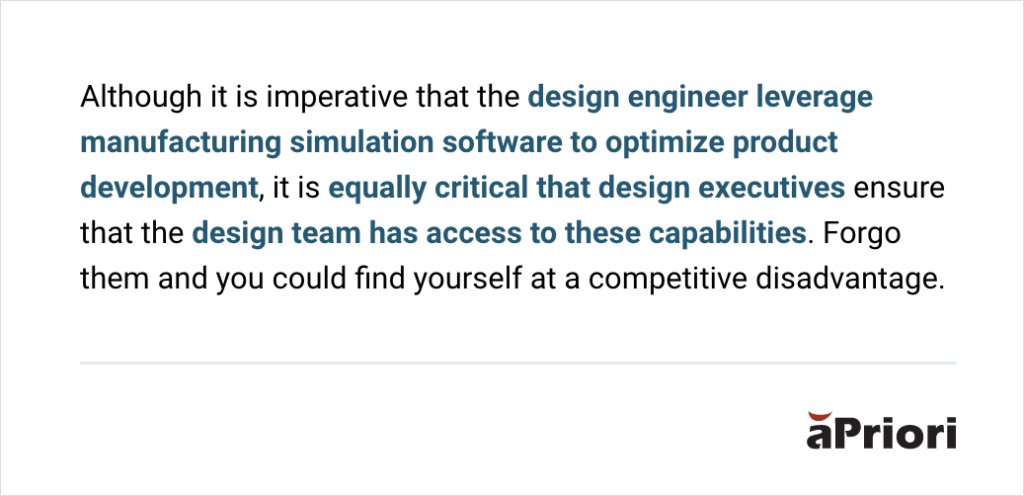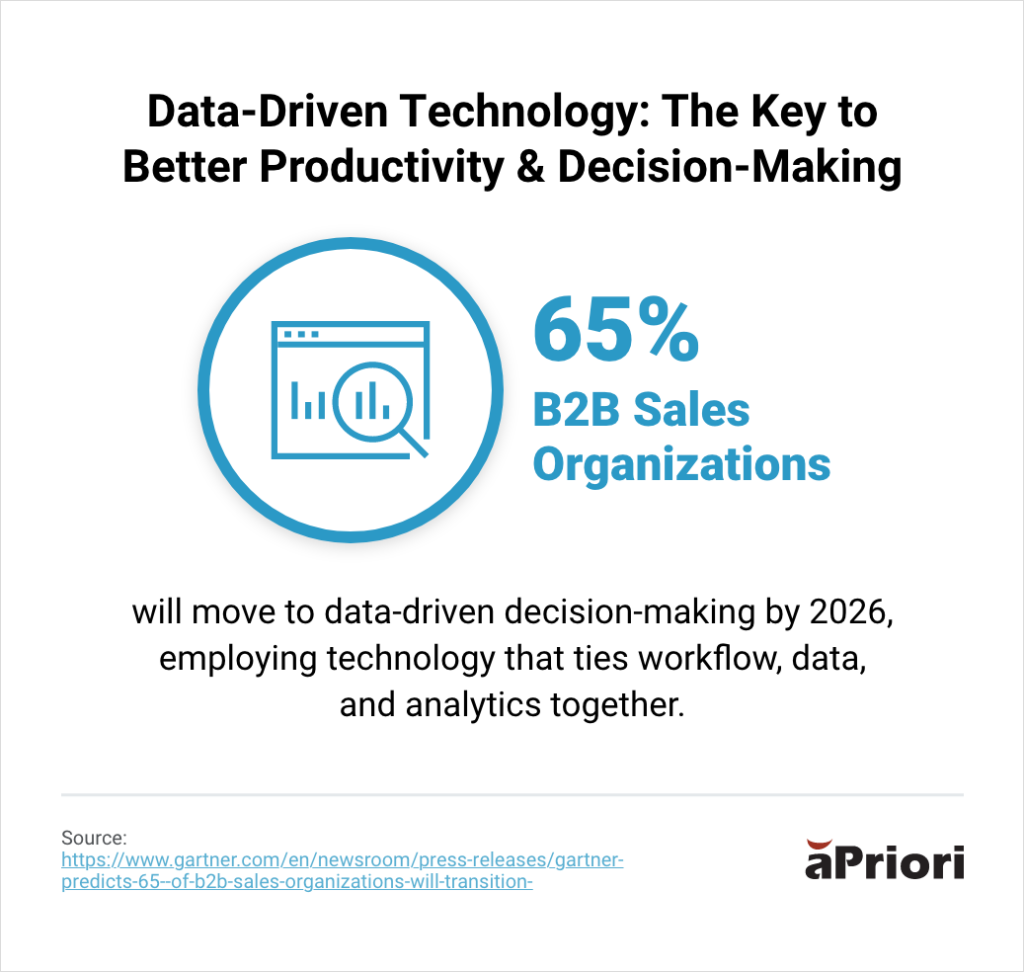Why Engineers Should Care More About Product Costs
Key Takeaways:
- Engineers rarely prioritize product costs because they are more focused on other aspects of product development, such as form, fit, and function
- Lack of data (and the lack of trust in it) are two key factors. Digital solutions like aPriori remove the roadblocks including traditional cost and time lags like Excel
- The result is accurate data to reduce costs, faster decision-making, more effective product development decision justifications, and accelerated time to market
The Full Article:
In the face of global trade wars and high prices on raw materials and labor wages, manufacturers must carefully consider every dollar and do more with less. For product development teams, the burden of proof falls squarely on their shoulders and it starts with the design engineers who wield the most spend influence in the process.
A product’s design accounts for approximately 80% of its total cost, yet design engineers have not traditionally prioritized cost. However, the design’s cost typically isn’t evaluated until the cost engineer reviews it. If it is cost-prohibitive, it has to go back to the design engineer to refine it in 3D CAD to meet cost targets.
Moreover, these engineers often lack the right data that a manufacturing simulation solution (like digital factories and supplier data libraries) provides to analyze the design properly or ensure that the required materials and parts from suppliers are cost-effective. Others may not have full confidence in the data they are provided or simply do not have the means to access data quickly to accelerate design decisions.
Engineers do care about product costs in manufacturing, but their focus tends to be on the following: A Forbes article notes that organizations should double down on their efforts to align their technology strategy with their business goals. Tools like digital twins, predictive analytics, and causal AI aid in this process to better anticipate and mitigate risk, improve processes, and enhance customer and staff experiences. Using data analytics and centralized knowledge management to make smarter, more insight-driven, cost-effective decisions further encourages a more cost-conscious culture. Without them, engineers might inadvertently compromise costs. The pitfalls of not considering costs in the design phase include: 1. Over-engineering: Problem: Engineers may design products with high-end, expensive materials, complex features, or advanced technologies that may be unnecessary and impractical from a market perspective. Consequence: The organization must make a decision to either: increase the product price leading to lower sales and profits OR maintain a competitive price while accepting lower margins and increased time to reach a return on investment (ROI). 2. Inefficient Manufacturing Processes: Problem: Engineers may design products that are difficult and/or expensive to manufacture. For example, they may create intricate designs that require complex manufacturing methods or specialized machinery, including unnecessarily high tolerances that require multiple machining processes, without considering the cost implications. Consequence: These designs can lead to inefficiencies in production, higher labor costs, longer lead times, and the need for multiple steps or utilizing expensive equipment, all of which drive up overall product costs. 3. Missed Cost-Reduction Opportunities: Problem: Engineers may not always be aware of opportunities to simplify designs, select less expensive materials that would not compromise product quality or functionality, or collaborate with teams downstream enabling them to get design costs right the first time. Consequence: Without input from engineers on cost-cutting measures, the company may miss out on valuable opportunities to lower the cost of goods sold (COGS), impacting profit margins. 4. Increased Inventory and Waste: Problem: Engineers may design products with parts that are expensive to manufacture or source, leading to more design iterations and engineering change orders (ECOs), especially in the late product development stages. Moreover, if an unnecessary yet complex manufacturing process is selected, it will increase the part’s cost since there is a limited skill set available to produce it without quality issues. Consequence: High material waste or parts that require excessive handling can increase production costs and inventory overhead or trigger costly ECOs. Additionally, unsold products or excess inventory can tie up resources and reduce cash flow. 5. Difficulty Scaling Production: Problem: A product that is well-engineered but expensive to produce or difficult to assemble may not scale easily as demand increases, potentially resulting in ECOs to remediate these issues. Consequence: Inability to scale up production efficiently can lead to delays (e.g., ECOs), production process bottlenecks, or the need to invest heavily in capacity expansion, all of which can increase unit costs. Other pitfalls include: The good news is that many of these design-at-the-cost-of-expense issues can be circumvented or at least mitigated. Ultimately, it boils down to manufacturers creating and fostering a more cost-conscious culture across the organization, and specifically, product development teams. Here are a few strategies to achieve it: Design engineers are the seminal point for reducing the cost of a product. A product’s design is the driving force in this cost. Solutions like aPriori provide immediate, highly detailed insights that design engineers can leverage to optimize a product’s quality and performance as well as cost targets. Other benefits include: Design is central to product development. However, it isn’t and shouldn’t be the sole focus. In a highly competitive environment, every stage of product development must be optimized for cost. aPriori can facilitate a more cost-conscious focus for design engineers to ensure that the total product cost is aligned with cost targets and business strategies. In turn, it will lead to greater profitability, which can drive more innovation and a competitive advantage.Why Engineers Don’t Prioritize Product Costs
The Pitfalls of Cost Apathy in Engineering
How aPriori Enhances Focus on Product Costs Within Existing Engineering Workflows
The Benefits of Product Cost-Focused Engineering
Shift From Design-Centric to Holistic Design
Gain A Competitive Advantage with 3D CAD-Driven Costing
Unlock new levels of speed, precision, and automation — critical advantages that drive better business outcomes.











